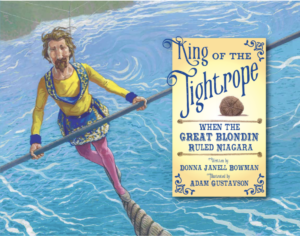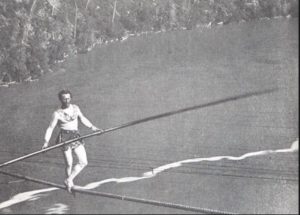I was honored to be featured on author Kirby Larson’s Friend Friday blog about how I was scooped (or pre-empted) on several books. Click here or scroll down to read about how choosing a new focus made King of the Tightrope: When the Great Blondin Ruled Niagara a much better book. For a chance to win a copy of King of the Tightrope, click on the Rafflecopter link on Kirby’s site here.
Friend Friday
Nobody warned me that falling in love with an idea worth writing about is risky. Nobody warned me that I could spend years researching and writing a book only to be scooped by another writer, as if they snuck into my headspace via Harry Potter’s pensieve. The reality is that the ideas swirling around us can be manifested by many writers within a short time. Once scooped, a writer has two choices: Abandon their project or commit to differentiating it.
I’ve been scooped many times. Some ideas simply didn’t have a strong enough hold to embolden me through the challenges, so they were set aside. For others, I’ve been willing to go to the proverbial mat with my muse. Such was the case when a competing picture book about Dr. William Key and Beautiful Jim Key hit shelves, years into my work on what would become Step Right Up: How Doc and Jim Key Taught the World About Kindness (Lee and Low, 2016). You couldn’t pry my heart and hands away from that story, so I did the work to make my book different. Deeper. Better than it was originally. Thank goodness!
Most recently, a fabulous (darn it!) picture book biography about Jean-Francois Gravelet, The Great Blondin, hit shelves in 2016, just as my now-soon-to-be-released book, King of the Tightrope: When the Great Blondin Ruled Niagara (Peachtree, October 2019), was going to contract. Cosmic coincidences happen, both in timing and similar story approaches. After my wee meltdown, my editor and I quickly decided that the best remedy was a new focus for my narrative.
The goal of any picture book biography is to share a true story, anchored by documented facts. A story. Not exposition. Not a cradle-to-grave information dump. My original focus in King of the Tightrope was the remarkable and daring feats that Blondin performed high over the Niagara River in 1859 and 1860. Though the determination and imagination themes remained in-tact, through re-envisioning the story, the focus shifted to the hows. In those days before electricity and technology, how did the funambulist accomplish this engineering feat? And why? How did he fenagle a 1300-foot-long, ten-inch-circumference rope across the raging Niagara River? How did he get the rope from the water to the cliffs? How did he stretch it, tighten it, stabilize it? How did he balance himself in that windy space?

Locating the unmarked spot of Blondin’s 1859 rope required investigation of print details and hikes along the American & Canadian cliffs.
The involved STEAM concepts required a new level of research that included engineers, a study of ropes and knots, a search for 19th century windlass options, a finer-toothed-comb cull through historical newspaper accounts and library archives, and a fortuitous connection with The Great Blondin’s great-great-grandson in France—someone I now consider a friend.
The new research led to revelations about fictionalized biographies and perpetuated falsehoods about Blondin. Writers and scholars have unwittingly relied on those falsehoods for almost 160-years. I had relied on them, too, until my new story focus required a deeper dive.
Nobody will warn you that getting scooped is a tantrum-worthy inconvenience. Re-envisioning one’s narrative takes time and effort. It is a balancing act in itself, but the view is mighty nice when you reach the other side.
Stay tuned for posts about the depth of my research and my discovery of perpetuated falsehoods from primary sources.




